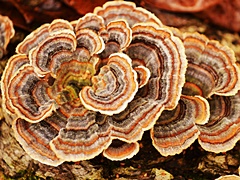
Welcome to Hemlock and Canadice Lakes!
Barns Businesses Cemeteries Churches Clinton & Sullivan Columns Communities Documents Events Time Line Fairs & Festivals Farm & Garden Hiking Homesteads Lake Cottages Lake Scenes Landscapes Library News Articles Old Maps Old Roads & Bridges Organizations People Photo Gallery Podcasts Railroad Reservoir Schools State Forest Veterans Videos
|
“Nature in the Little Finger Lakes” by Angela Cannon Crothers |
|
|
Fantastic Fungi Angela Cannon-Crothers October 2017 I’m out foraying for turkey tails, but not the kind with feathers. The tails I seek are only 1 to 2 inches across, sometimes less. I find them on fallen logs-usually a multitude that have fissured along the log as if splitting a seam, in a row or two of tail fans. These turkey tails are Trametes versicolor, a fungi. Fairy cup, earthstar, death angel, troll smör, witch’s butter, dryad’s saddle, dead man’s fingers, bearded tooth, old man of the woods, poison pie ... such names speak more of Halloween and fairy tales than feasts. These names for a group of organisms known almost entirely by scientific Latin names capture the mystique of a kingdom like none other on earth. The cool and heavy rains of this past summer flared up a kaleidoscope of edible fruiting fungi—mushrooms like chanterelles, black trumpets, and king boletes, to name a few. During the BioBlitz at Cumming Nature Center in July, 34 species of fungi were identified in just one day. Mushrooms are made up of numerous, miniscule, thin strands of mycelium. What we see emerge from the ground or sides of trees are actually their reproductive, spore-producing structures. The variety of mushrooms (about 30,000 of the 100 million known fungi) are further broken down into phylums (mostly by reproductive types), families, and genus: with and without gills, stems or no stems, jellied, club-shaped, coral, and so forth. But what is even more fascinating than their shapes, colors, aromas, and tastes is what they do. Fungi like late fall oyster mushrooms (Pleurotus ostreatus) on the side of a moribund poplar tree, or shitake (Lentinula edodes) spawn inoculated into fresh cut oak logs, are primary decomposers termed saprophytic. Such fungi come in to do the initial breaking down of the woody material of the tree. After a couple years, when the logs appear to be fairly well-rotted, secondary decomposers, like the inky cap (Coprinus atramentarius) join forces with other bacteria and microscopic fungi to finish the process of decay. When what once was a tree finally resembles more soil than stump, tertiary decomposers, the true soil-dwelling mushrooms, like species of Agaricus and Mycena, in a complex relationship with other organisms, continue the decomposition process down to the minutest details of nutrient recycling. There are also parasitic mushrooms, something more akin to a pack of wolves sniffing out the weakest members of the forest. (Fungi are more closely related to animals than to plants, by the way.) And there are saprobic fungi, a term that blends different opportunists, like the dead man’s fingers, around my perishing new Juneberry tree (sigh!). Most impressive are the mycorrhizal mushrooms, often termed “The Wood-Wide Web.” Mycorrhizal mushrooms work in symbiotic partnership with the roots of trees and other plants, forming a network of mutually beneficial nutrient transfers between the trees, even those of different species, providing information on where other nutrients can be found, protecting roots from invading organisms, and doing much, much more. Some of these include boletes, chanterelles, russula, and the legendary truffle. Fall through November is a great time to go out and get to know some mushrooms. There are colorful turkey tails (Trametes versicolor) for jewelry, papermaking, and medicine, as well as other medicinals, like Ganoderma lucidum and maitake. You may find artist’s conk polypore to sketch a drawing into or dyer’s polypore (Phaleolus schweinitizii). If you are lucky enough you may come across jack-olantern fungi (Omphalotus olearius) whose gills actually glow in the dark. And if you have a couple of mushroom field guides and clearly understand the processes in which to identify edibles, you may find hen of the woods (Grifola frondosa) below oaks, sulphur shelf (Laetiporus sulphureus) which tastes like chicken (but should never be consumed with alcohol), bearded tooth (Hericium erinaceus) with a taste and texture like seafood, and giant puffball (Calvatia gigantean), which really tastes like nothing at all. Delicacy or deadly, there is much more to explore in the fantastic and colorful world of fungi than edibility. After all, it’s an entire kingdom out there.
|
||
|
Editor’s Note: Angela Cannon Crothers is a naturalist and writer who teaches at Finger Lakes Community College and with The Finger Lakes Museum. Here are some columns that she has written about the Little Finger Lakes. Her columns also appear in the Lake Country Weekender newspaper.
|
||
